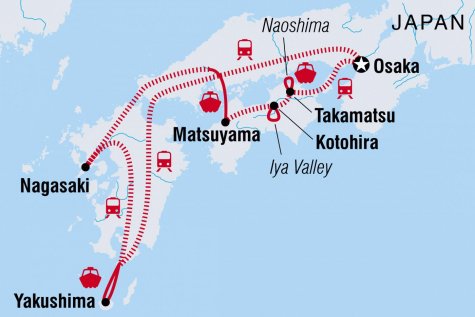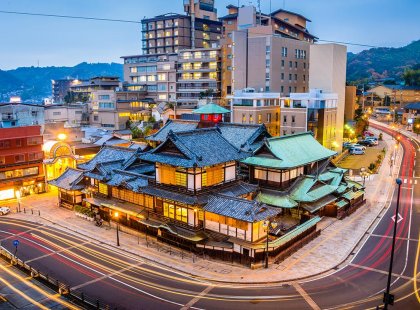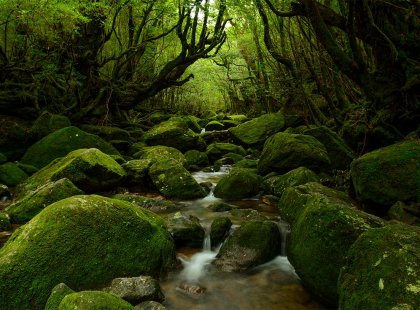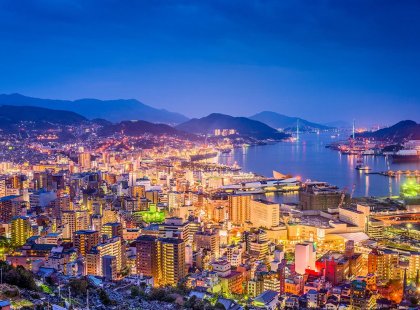Southern Japan Experience
12 days
from Osaka Wan to Osaka Wan
From
$ 4225
Duration12 days
Experience south Japan through its tranquil shrines, magical forests, inspring art, steaming onsen and a lot more. One of Japan’s greatest attractions is its ability to offer up both the modern and traditional versions of itself. Alongside future-focused cities like Osaka and Nagasaki, there are places that have kept to its traditions for hundreds of years, often to stunning effect. Set off on a journey of discovery into the Japan that lies south west of Osaka, a ‘lost Japan’. Travel also to Takamatsu and Naoshima Islands and be amazed at the contrast between the traditional beauty of the Ritsurin garden and the local avant-garde art exhibits.
-
Duration: 12 daysService level: Standard
-
Starts in: Osaka WanPhysical Grading: Average
-
Ends in: Osaka WanAges: 15+

Itinerary
Day 1: Osaka
Start place: Osaka Wan
Konnichiwa! Welcome to Osaka, Japan. Ever-vibrant Osaka is also the country’s unofficial culinary capital, where the motto is 'Kuidaore' ('eat until you drop'). Your adventure begins with a welcome meeting at 6 pm where you'll meet your tour guide and fellow travellers. You can arrive at any time during the day, as there are no activities planned until this important meeting. Please check with hotel reception or look on the reception noticeboard for where and when the meeting will take place. Have your insurance and emergency contact details on hand as we'll be checking them at this meeting. After the meeting, perhaps join your new travel companions for an optional dinner at a local restaurant.
Day 2: Takamatsu
Depart Osaka this morning and begin the journey west. Take the train across the bridge spanning the stunning Inland Sea and onto Takamatsu (approximately approx 3-4 hours). This may be the largest city on the island of Shikoku (the smallest of Japan’s four main islands), but it's a beautifully unpretentious town full of history, top-notch food and interesting local art. Here you'll visit Ritsurin Garden, one of the most beautiful gardens in the country. Dating back to the Edo period, it comprises several ponds and arched bridges designed around strolling paths, tea pavilions and historic trees, with a western garden an addition to the Japanese one. The garden also houses the Sanuki Folkcraft Museum which displays a variety of ceramics and basket-work dating from the time of the Tokugawa shoguns.
Day 3: Naoshima - Takamatsu
Take the ferry (around 1 hour) for a day-trip to the island of Naoshima, located in the Inland Sea between Takamatsu and the mainland, which is famous worldwide for its modern art galleries, museums, avante-garde architecture and lovely natural setting. Explore the island by public bus or bicycle to take you between the different galleries and installations. Wander between artworks, hear the sound of waves lapping at quiet coves, and stumble unexpectedly upon outdoor sculptures. Return to Takayama after a full day on the island.
Day 4: Kotohira
It's back on the train this morning and off to the small town of Kotohira (around 90 mins), which is famous for Kompira-san, Shikoku's most celebrated shrine. Popular with pilgrims, Kompira-san is dedicated to seafaring, and although the approach to the shrine is not particularly straightforward, it's well worth the effort. Passing some historical landmarks on the way, climb the 785 steps to the main hall and take in views overlooking Kotohira Town and the Inland Sea far below and check out a real submarine on display. For those interested, just to the east of the entrance to Kompira-san you can also find Kanamaru-za, said to be one of the oldest kabuki theatres in Japan. You can go backstage and see how they ingeniously worked the revolving stage and trapdoor hundreds of years ago. Stay overnight in a small guesthouse tonight.
Day 5: Iya Valley - Matsuyama
Before heading west by train along the Inland Sea coast to the attractive castle-town of Matsuyama, we make a day trip to the secluded Iya Valley by local train and private coach. Traverse the winding passes and head to the atmospheric Kazura-bashi (which translates as ‘vine bridge’) located in a remote part of Oku-Iya (known as ‘deep Iya’). When the Heike clan fled here some 800 years ago, they built these bridges as the only way to span the gorges and Iya River; if they were attacked then they could cut the vines at a moment’s notice. Only three of these bridges remain, and they look like something out of Indiana Jones. You'll also visit the Nagoro ‘scarecrow village’, where a local artist 'repopulated' the dwindlling village by positioning life size scarecrows through the village, and Buke Yashiki, a restored thatched-roof samurai house which lies at the top of a steep valley slope and towering cedar trees. This was once the home of village leaders, and now offers displays of samurai armour and superb views over the valley.
Day 6: Matsuyama
This morning, visit hill-top Matsuyama Castle, one of Japan's finest surviving castles and located right in the middle of this lovely provincial capital with its old trams and refined feel. Unlike most castles in Japan, this one has an interesting collection of artefacts inside, so take the chance to check them out and learn a little more about Matsuyama's feudal history. With free time in the afternoon, maybe relax and unwind at the beautiful Dogo Onsen, one of the oldest bath houses in Japan, or visit Ishiteji Temple which is the 51st of the 88 temples that make up Shikoku’s ‘88 Sacred Temples’ circuit, Japan’s most famous pilgrimage route.
Day 7: Nagasaki
We have a long day of travel ahead of us today (around 8 hours in total) as we leave Shikoku, cross the beautiful Inland Sea once more and head further west to Kyushu, the third largest of Japan’s four main islands. We arrive in Nagasaki in the afternoon and have an orientation walk with our leader to stretch our legs after our journey. Though its name has strong connotations of bombs and war – and the military history sites are important to visit – Nagasaki is a delight to explore, with its hills and harbour, shrines and temples, churches and other remnants from its long involvement with Asian and European traders.
Day 8: Nagasaki
This morning, visit the Peace Park and Atomic Bomb Museum for a sobering reminder on what happened on that dreadful day of 9 August 1945. If you wish to reflect and explore further, there are other interesting museums nearby worth visiting. With a tram pass at your disposal, take the time to explore other parts of Nagasaki in the afternoon. Consider heading over to Dejima. This fascinating artificial island, once a Dutch trading post in the 17-19th centuries (and the sole foreign presence in the whole country at one point) is well worth exploring. The 26 Martyrs Memorial, Oura Catholic Church, Glover Garden and Dutch Slopes also give you a glimpse into the life of the early Christians and European traders in Japan. Then in the evening, perhaps slurp on some champon noodles – ramen Nagasaki-style!
Day 9: Yakushima
From Nagasaki we take a limited express and shinkansen bullet train through Kyushu’s attractive hinterland to its southern-most point. Here jump on a hydrofoil to travel a few hours to the island of Yakushima, arriving in the afternoon. A remote island even by Japanese standards, the journey is well worth the effort. Much of Yakushima’s adundant natural resources have been preserved without exploitation, making it particularly picturesque. It was justifiably added to UNESCO’s World Heritage list in 1993. The forests of Yakushima are said to have inspired the forest setting in Hayao Miyazaki's film ‘Princess Mononoke’, and it's easy to see why. Its ancient cedar trees and shady green splendour are a delight to behold, and at times give the feeling of walking through another world. Your stay in Yakushima will most certainly be one full of magic. Tonight we enjoy a dinner of local Yakushima cuisine.
Meals: D
Day 10: Yakushima
Set off on a hike today through the lush green forests of Yakusugi Land (approximately 2.5 hours). Yakusugi Land is a beautiful national park home to the ‘yakusugi’ – the island’s magnificent ancient cedar trees which are over 1000 years old (some are as old as 3000 years!). If you’re lucky along the way you might encounter a Yakushika deer or Yakuzaru monkey. After your hike, kick back and relax. You may want to spend some free time soaking in the natural onsen baths by Yakushima’s shoreline. In the summer season (May-July), the lovely Nagata Inaka-hama Beach is the place to be. Here, when it's the season, giant turtles lay their eggs in the sand at night.
Day 11: Osaka
Say goodbye to the magical forests of Yakushima and jump back on the hydrofoil and head back by shinkansen through Kyushu to Osaka. Tonight you have the option to join your leader and travel companions for a final celebration of your time in Japan.
Day 12: Osaka
The trip comes to an end this morning. There are no planned activities today.
End place: Osaka Wan
Inclusions
Included
- Takamatsu - Ritsurin Garden & Sanuki Folkcraft Museum
- Takamatsu - Naoshima Island day trip (ferry, local bus & bicycle)
- Kotohira - Kompira-san Shrine
- Iya Valley - Iya Valley day tour (including Buke Yashiki samurai house and ‘scarecrow village’)
- Matsuyama - Matsuyama Castle
- Nagasaki - tram day pass
- Nagasaki - Peace Park & Atomic Bomb Museum
- Yakushima - Yakusugi Land National Park hiking
-
Transport
Train, Ferry, Public Bus, Private bus, Metro, Bullet Train -
Accommodation
Hotel/Ryokan (11nights)






